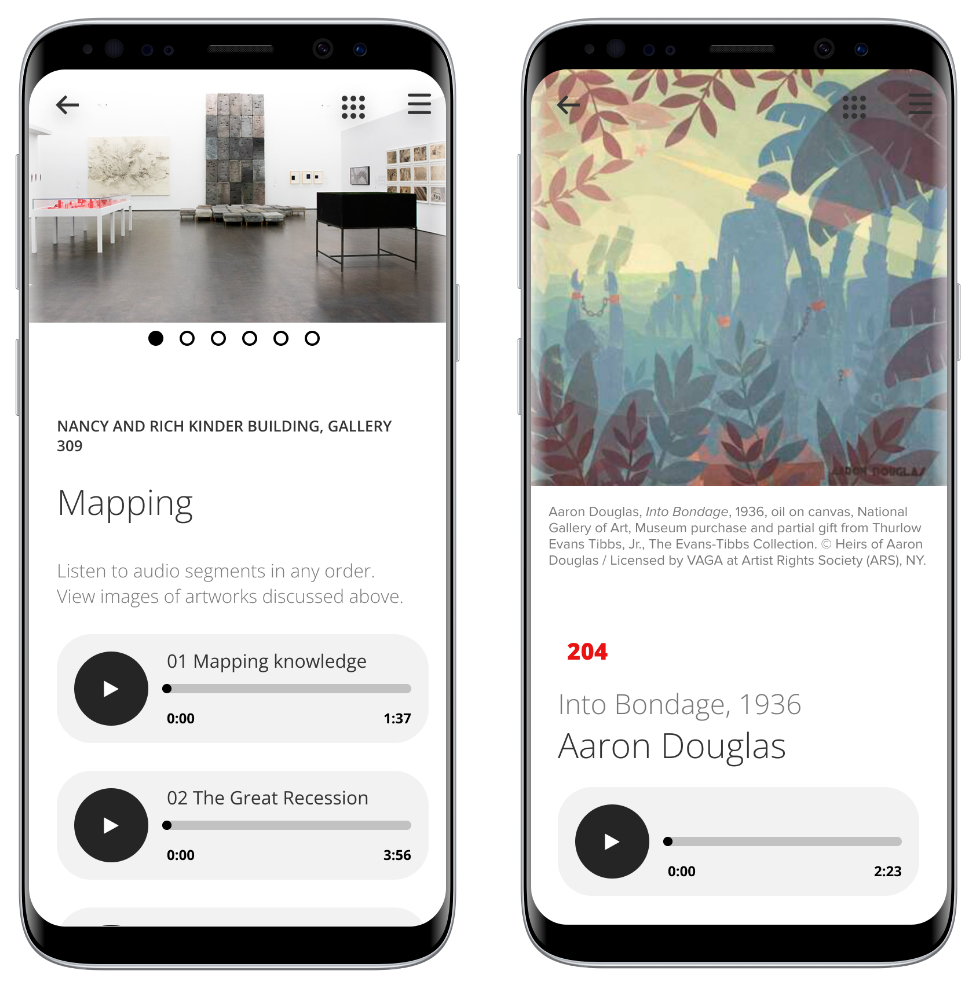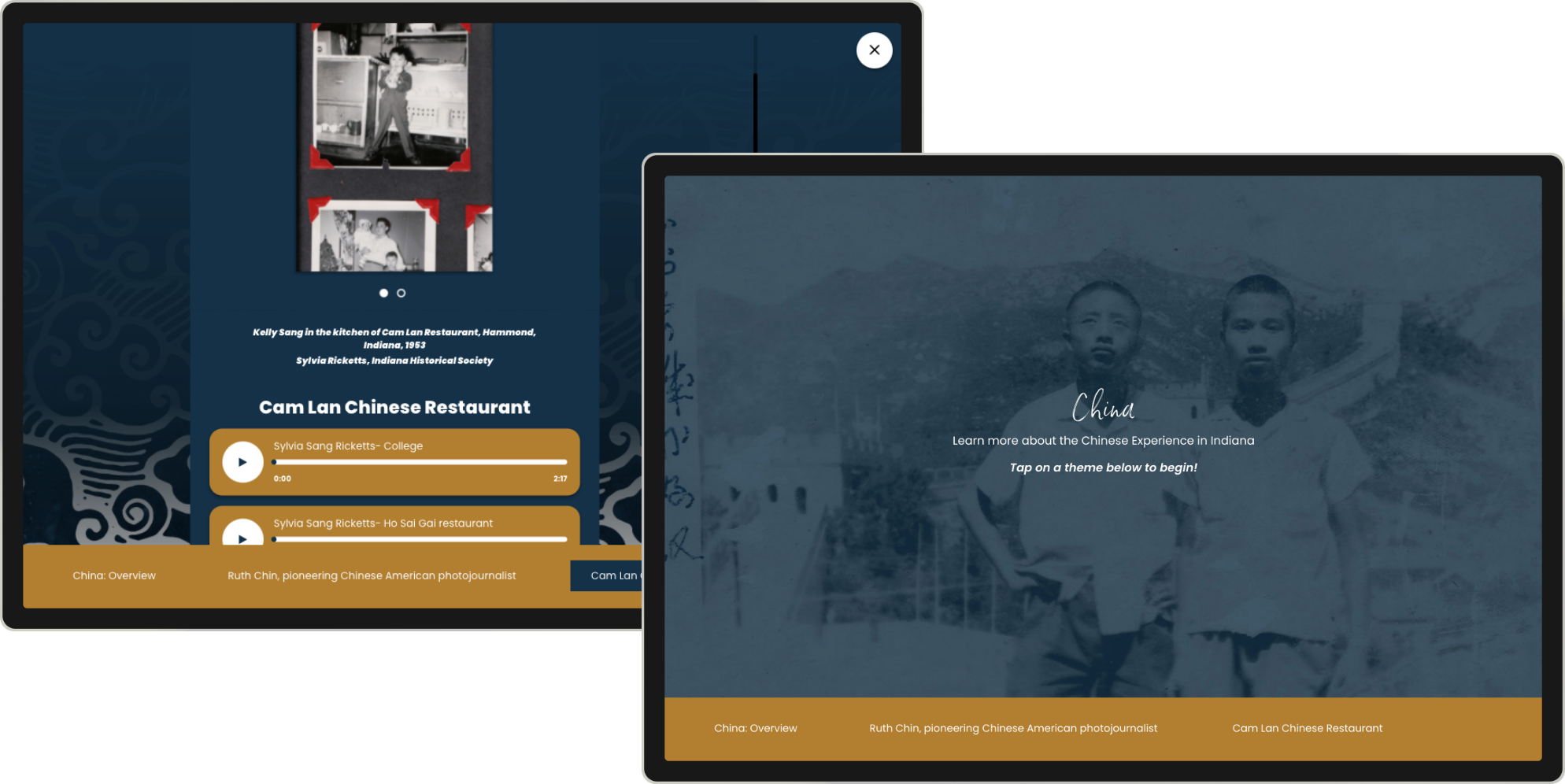
Not-So-Traditional Audio Guides
Video experiences took the lead on client projects in 2020 and 2021 but with visitor traffic increasing, we’re witnessing a renewed interest in audio tours, oral histories, playlists, and everything audio.
Check out how the Museum of Fine Arts, Houston, Indiana Historical Society, Munson-Williams Museum of Art, Bell Museum of Natural History, Holocaust Memorial Center, and KMAC Museum are deploying live and pre-recorded audio experiences to engage visitors on their personal devices.
Why Audio?
- Audio allows visitors to keep their eyes on the exhibition, collection, or historic site
- Audio is hands-free! Click play and put your phone away
- Audio offers visitors interpretation across multiple languages
- Audio is immersive – audio guides can include music, atmospheric sounds, as well as interpretation
AMPLIFY DIVERSE VOICES & PERSPECTIVES
The choice of narrator(s), the type of audio experience, and the style of audio vary widely and museum content creators are getting more inventive. Check out a few innovative approaches to using pre-recorded audio to engage your audience.
Museum of Fine Arts, Houston
When the MFA, Houston relaunched their audio guide in 2019 they decided to bring multiple subject experts into the conversation. Visitors are often welcomed into tours by the Director, Gary Tintertow, who helps set the stage for the upcoming interpretive experience. As visitors traverse the exhibitions, they’re offered multiple audio experiences from narrators, curators, artists, artist families, and more.
The audio experiences are often conversational, they sometimes aim to share historical context but also free the speaker to focus on key artworks, stories, or memories and deep dive into why particular works in a show exemplify the exhibition’s themes. The overall effect is an innovative audio guide that keeps visitors engaged – the voice, the perspective, and the content are never predictable.
Check out the app here.
Check out the MFA, Houston case study here.
LET HISTORY SPEAK FOR ITSELF
Indiana Historical Society
While the Indiana Historical Society’s apps are not technically mobile guides, the significance of audio in their interpretive experiences can’t be overstated. In two online exhibitions which supplement onsite exhibitions, You Are There and Be Heard, audiences are immersed in audio experiences which are profound in their depth and breadth. Audio helps us connect with history, personal stories, and music.
You Are There 1915: Madame C.J. Walker, Empowering Women
The first online exhibition in the You Are There series focuses on the incredible life of entrepreneur, Madame C.J. Walker. The Racism in Walker’s America experience is especially profound as it shares first-person interpretations which recount racism and discrimination experienced and witnessed by key figures in Walker’s life.
These first-person accounts reveal the ever-present issue of racism in Walker’s life.
You Are There 1927: Gennett Studio
Gennett was an American record company in Richmond Indiana which flourished in the 1920s until the middle of the century and has continued to impact American music. Gennett produced some of the earliest recordings by Louis Armstrong, King Oliver, Bix Beiderbecke, and Hoagy Carmichael.
Here, audio helps bring the studio to life for contemporary audiences but also create connections between Gennett Studio musicians and contemporary musicians. In this online exhibition, audiences can listen to Miles Davis, Nina Simone but also artists like Jay-Z and Bruno Mars.
Be Heard
Beginning in the Fall of 2016, the Indiana Historical Society began a project of collecting previously understudied stories. That project developed into a series of exhibitions under the title “Be Heard.” This online exhibition focuses on Asian Experiences, Latino Experiences, and Groundbreaking Black Hoosiers.
Within each experience, individuals from local communities share their personal histories through audio recordings. Audiences are encouraged to listen to a wide variety of stories but may also do a deep dive.
The You Are There and Be Heard online exhibitions will publicly launch December 2021. Circle back here at the end of the year for live links to these applications.
CREATE A COMMUNITY OF VOICES
Bell Museum
When the Bell Museum, in partnership with CultureConnect and QMedia, began their Minnesota Journey’s audio guide project, audio was the focus of the content strategy, design, and user experience. The mobile guide would offer onsite interpretation for all galleries via audio, images, and transcription.
The narrator helps visitors navigate into and out of galleries (including a friendly welcome in the lobby,) and explore physical exhibitions and physical interactives, all while taking a narrative approach. The audio guide is truly a journey through the museum but also the history of the world and life on Earth.
Not only did the Bell Museum team launch an immersive audio experience, it is also provided multilingually in English, Spanish, Hmong, and Somali. All local communities are welcome to have an equally immersive experience discovering the museum’s new permanent galleries. To top it off, the Bell Museum made sure the app was compliant with federal accessibility standards and launched an Audio Description tour.
Check out the app here.
Check out the case study here.
Munson-Williams Proctor Arts Institute
The Munson-Williams team publicly launched their current audio guide in 2018. The initial tours focus on audio and text comments from Museum curators and artist Kay WalkingStick as visitors explore the permanent collection. Their Let’s Talk Art tour is a conversation-based Museum guide suitable for a diverse range of ages and abilities which works especially well with memory care patients and caregivers.
In 2021, the Museum team went beyond the museum walls and out into their community. Coming Into View – Call and Response opens up the collection interpretation to members of the Utica community. Here, members of the local African American community respond to artworks in the Call and Response: Collecting African American Art exhibition, and share their personal experiences and interpretations through text, personal images, audio, and video. The audio then serves the dual purpose of sharing collection interpretation while also capturing important oral histories from local families.
Check out the app here.
Check out the MWPAI case study here.
OFFER DYNAMIC AUDIO
KMAC Museum
The KMAC Museum mobile guide is a media-rich, artist-driven exploration of the museum’s collection and temporary exhibitions. Audio and video are used to literally give artists a voice in the visitor’s exhibition exploration. As visitors explore artworks, they’re welcome to listen to pre-recorded interviews with artists, watch video interviews with artists, as well as tap into podcasts which help provide context.
KMAC Museum was the first team on the CultureConnect platform to bring the Universal Embed feature into their digital interpretation. They’ve deployed videos, podcasts, and 360 tours hosted by Matterport across their exhibition tours.
Check out the app here.
LIVE AUDIO EXPERIENCES
Holocaust Memorial Center
The Holocaust Memorial Center launched a comprehensive mobile guide which encourages visitors to explore exhibitions, the permanent collection, and survivor stories at their own pace. Visitors can opt into two audio experiences:
- The self-guided tour includes pre-recorded audio interpretation, video, translations, transcriptions of original letters and documents, and more. With self-guided exploration, visitors get to dive deep into history and the collection.
- The second experience is a live guided group tour which is offered every Friday and Sunday to the public. Like the self-guided tour, visitors arrive with their group, access the application on their phone but instead of selecting the self-guided option, they join the guided tour. Each tour is led by Holocaust Memorial Center staff. These premium live guided experiences offer enhanced learning experiences because each staff member brings their personal knowledge of the collection to the presentation.
The Holocaust Memorial Center was the first museum on the CultureConnect platform to launch a Group Tour program and their onsite testing and feedback was essential to fine-tuning the product for future museum deployment. Key benefits of the program:
- No hardware required – visitors use their own devices. No cleaning, charging, or device maintenance required from the Holocaust Memorial Center team.
- Visitors are able to use the full application as needed – this frees them to listen to their tour guide while also exploring the self-guided tour to collection items in more detail, access translations, and save pages as favorites for exploration on their own once the tour is complete.
- Wifi-based technology – no bluetooth or other special signal technology required.
- No proximity requirements – visitors can maintain social distancing and be as far apart from others as desired.
How does the live Group tour experience work?
CultureConnect’s Group Tour technology allows tour attendees to join live guided tours via their own device and headphones. The tour guide is able to time their walk-through, view the number of active participants, and mute themselves as needed. Tour attendees enjoy crystal clear real-time audio with the option to visit other pages in the app while staying connected to the live tour. Museum teams love this solution because it means no hardware necessary! This feature minimizes the expense around hardware, charging stations, and cleaning. For a deep dive, check out our article on CultureConnect’s Group Tour technology here.
Want to learn more?
Connect with the CultureConnect team to learn more about the platform here or by emailing hello@cultureconnectme.com











